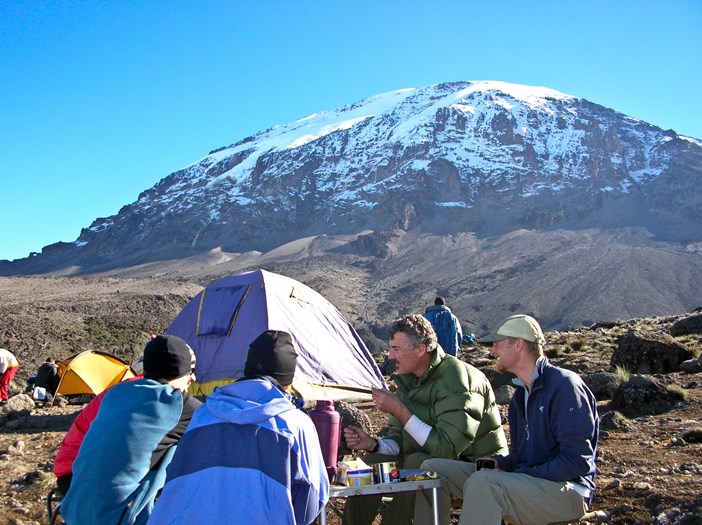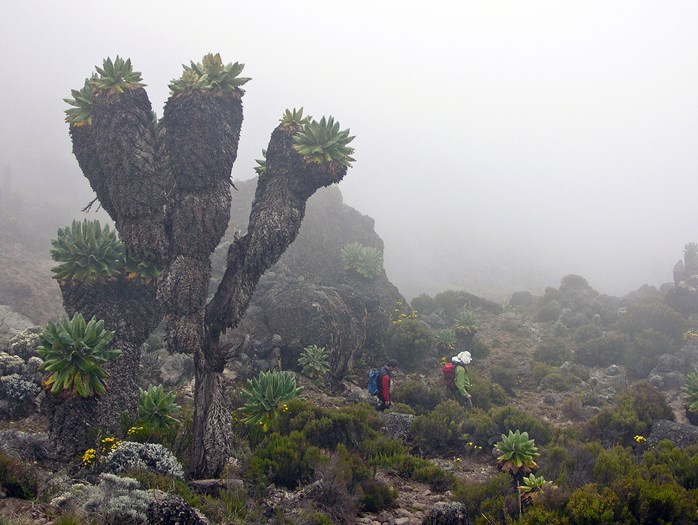THE ROOF OF THE WORLD – As dawn breaks over the carpet of clouds obscuring the Serengeti Plains kilometres below, I let out a whoop of joy. I’m on top of Africa.
On the verge of hypothermia, I’m also punch drunk from the effects of extreme altitude. But none of that matters now because I’m finally standing on top of the enormous glacial summit cap that Hemingway called “as wide as all the world ... great, high, and unbelievably white in the sun.”
I’ve just completed the hardest hike of my life — seven hours of grinding ascent to the summit of 5,900-metre-high Mount Kilimanjaro. Buffeted by ferocious winds along a steep, rocky path lit only by a full moon and my flickering headlamp, I’ve suffered waves of nausea, low thudding headaches, and fits of gasping, wheezing, cursing and self pity. Many times I’ve wanted to turn back since departing camp at midnight.
But for now I’m giddy with the rush of success. All the discomforts of the past six days — long slogs, sore feet, cold tents, and nagging headaches — seem infinitely worth it. Dream realized, I embrace my climbing companions, and then fumble to snap a few photos with numb hands.
I’ll only spend about 20 minutes on the roof of Africa, which is as high as I’m ever likely to go under my own steam. But it’s high enough to have entered the first rung of the Seven Summit ladder.

Above: Climbers relax before making their final push to the top.
In 1985, a 55-year old American billionaire named Dick Bass became the first man to climb and popularize the so-called Seven Summits — the highest peak on each continent, of which Kilimanjaro is one. Thanks to Bass, mere mortals like me who get vertigo watching IMAX films could hopefully one day brag over beers about being a Seven Summiteer.
For non-mountaineers, Kilimanjaro is the logical first stab at alpine glory. You can reach the summit via routes scalable without technical climbing knowledge. All you need are sturdy legs and lungs, relatively deep pockets, and the willingness to risk headaches, nausea, vomiting and other assorted hazards associated with altitude sickness.
A good guide doesn’t hurt either. Mine is California native Jacob Schmitz, who earned his alpine chops scaling the vertical face of Yosemite’s massive El Captain, one of the world’s premiere rock climbing walls.Over the past decade Jacob has climbed more than 35 big walls and more than 100 peaks in the Sierras, summated Mount Aconcagua (the highest peak in the Western Hemisphere) several times, and holds speed ascent records in Yosemite and first alpine style ascents in Patagonia. This is his fifth ascent of Kilimanjaro. In other words, I’m in good hands.
Jacob works for Alaska Mountain Guides (AMG), one of North America’s most respected climbing, trekking, and adventure companies. For nearly 20 years, AMG has been offering city slickers like me a once-in-a-lifetime opportunity to push our limits in some of the world’s most unique and intriguing places.
Earlier, during our pre-summit push briefing, Jacob laid down the law: “If I decide that any of you cannot safely go on for any reason as we ascend tonight, I will not hesitate to order you to descend immediately. There will be no arguments. No debates. I am responsible for your safety up here. And my word is final.”
Why the lecture? Even though mountaineering hazards such as crevasses and avalanches aren’t a factor on most Kilimanjaro routes, there are still serious risks. Since we began the trek, Jacob and our Tanzanian co-leader, Abdi Abdi Kasim, have been constantly reminding us to go pole! pole! (slowly, slowly in Swahili). Maintaining an incremental rate of ascent can mean more than the difference between success and failure on Kilimanjaro. In extreme cases, it’s a matter of life and death.
At altitudes above 3,000 metres, your body begins adjusting to the decreased availability of oxygen by increasing production of red blood corpuscles in order to maintain sufficient tissue oxygenation.
Climbing too high, too fast can induce cerebral or pulmonary edema, the most deadly of altitude-induced disorders. With pulmonary edema your tissues leak fluid into your lungs, eventually drowning you. Cerebral edema is a buildup of water on the brain, which can be deadly.
Fitness is no guarantee of avoidance; it all comes down to a physiological lottery — some people get it, some don’t, and nobody can predict whom. The most effective treatment for cerebral or pulmonary edema is rapid descent.
I’m one of the lucky ones. Although I’ve had trouble sleeping above 4,000 metres, and have felt nauseous on occasion, I haven’t yet vomited or been completely paralyzed by an industrial strength, altitude induced headache.
As I climb ever higher, I begin to appreciate why renowned climber and filmmaker David Brashears called Kilimanjaro the only place on the planet where you can journey from the Amazon to the North Pole in less than a week. Lying just three degrees south of the Equator, straddling the border of Kenya and Tanzania, Kilimanjaro is the largest freestanding mountain on Earth, and a self-contained ecosystem.
On a typical week-long climb you will pass through banana plantations, a rain forest, a cloud forest, and a high alpine plateau dotted with giant groundsels and lobelias, some over six metres tall. Eventually, you reach a barren landscape of black volcanic shale and huge boulder fields sprinkled with gargantuan cacti and yucca trees.

Above: The area's lush vegetation surprises first-time climbers.
In my increasingly oxygen-depleted state, it all starts to resemble the fantastic setting of a Dr. Suess story — until we reach the shrinking summit ice cap, which scientists estimate will all be gone by 2020; a high profile casualty of global warming.
If anyone still needs visceral proof that global warming is real, they need only look to Kilimanjaro to see that the roof of Africa’s most famous icon is melting, and fast.
It doesn’t feel like anything is melting except my leg strength as I begin the long, arduous descent from the summit down an endless scree slope. Four hours later I reach camp, and collapse exhausted in my tent. In the moments before this newly minted conqueror of Kili fades to black, I think to myself that one out of seven isn’t so bad at all.
About the Author
During nearly a decade as a travel writer and photographer, Vancouver-based Mark Sissons has always subscribed to T.S. Elliot’s maxim - “The journey not the arrival matters.”
Mark’s journeys have taken him to five continents on dozens of adventures but he holds a special place in his heart for Africa and its wild creatures.
During numerous visits to East and Southern Africa he has ballooned over the Serengeti, explored the Zambezi by canoe, learned what it takes to be a safari guide and summited Kilimanjaro, among many other adventures. As well as Travelife, Mark writes for numerous major publications, including Men’s Journal, the San Francisco Chronicle, the Huffington Post, the Toronto Star, Globe and Mail and the Vancouver Sun.